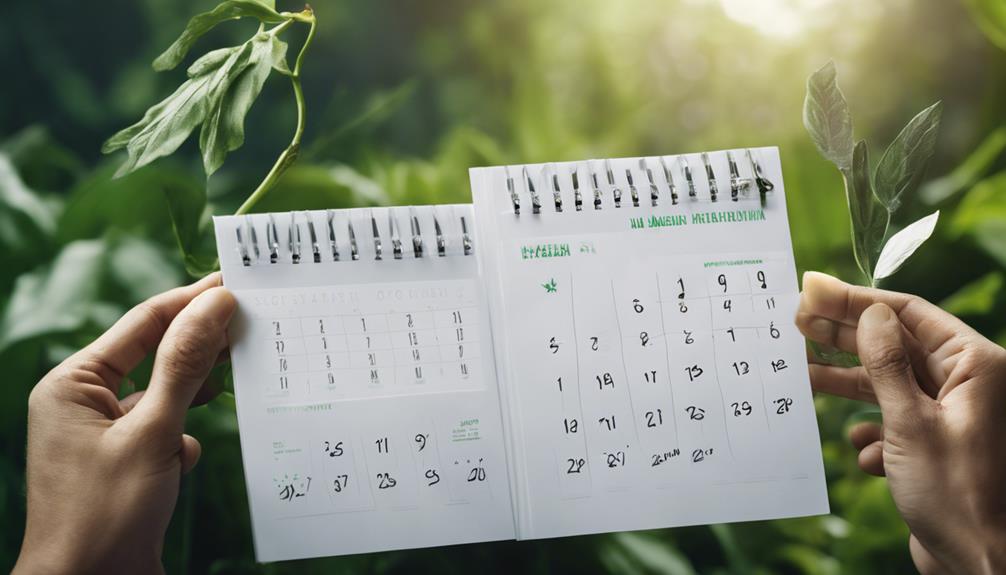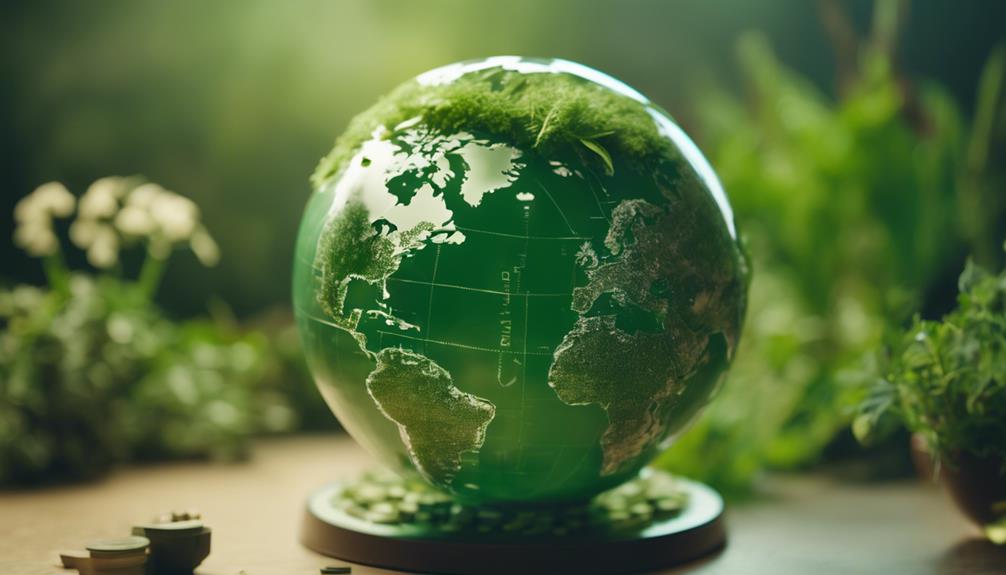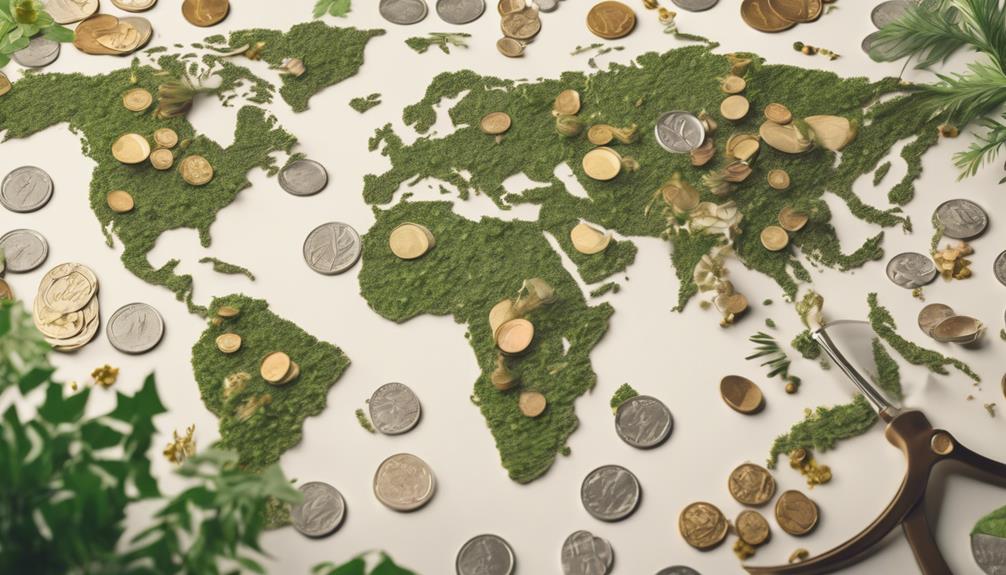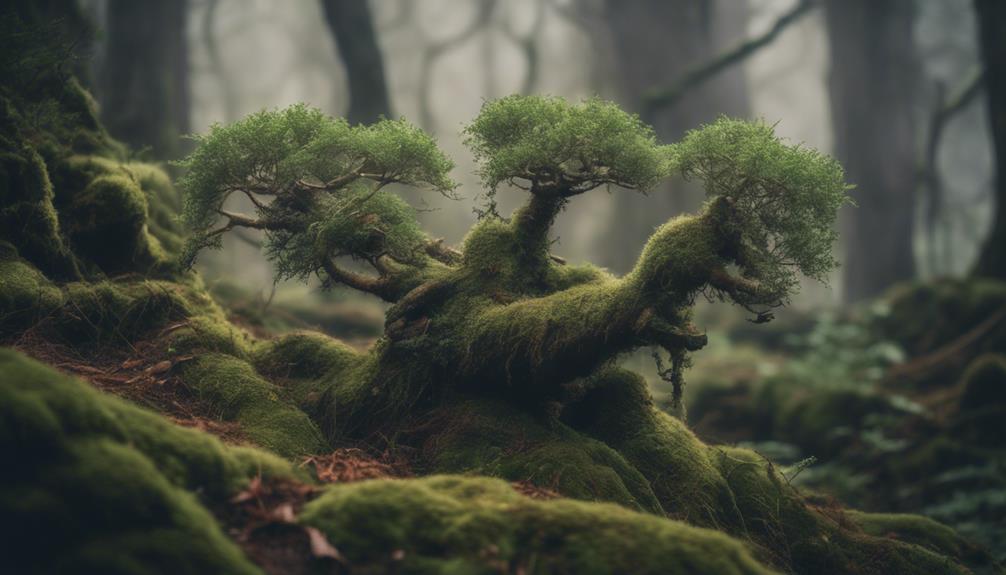We've analyzed the data, and it's clear that herbalists in Australia earn the highest average salary, with a median annual income of AU$55,000, followed closely by the United States, where herbalists can expect to earn around $50,000 per year. The UK, Canada, and Germany also rank high on the list, with median salaries ranging from £25,000 to €40,000. But that's not all – we've also uncovered a range of higher-paying herbalist careers, from clinical herbalists to entrepreneurs, as well as the benefits of specialized certifications and training. There's more to explore on this topic, and the insights that follow are just as valuable.
Key Takeaways
• Herbalists in Australia earn the highest average salary, at AU$55,000, followed closely by those in the United Kingdom at £25,000.
• The United States offers a wide salary range for herbalists, from $49,403 to $73,822, depending on location and experience.
• Experienced herbalists with advanced education and certifications can earn over $150,000 annually, particularly those in clinical settings or with successful products.
• Urban herbalists tend to earn more than their rural counterparts, due to higher demand and larger client bases in cities.
• Specialized certifications, such as the Certified Herbalist (CH) or Certified Clinical Herbalist (CCH), can significantly increase earning potential and credibility.
Top-Paying Countries for Herbalists
As we investigate the top-paying countries for herbalists, we find that the United States, United Kingdom, Canada, Australia, and Germany lead the way when it comes to lucrative career opportunities. These countries offer professional herbalists a promising average herbalist salary, with varying salary ranges depending on factors like location and experience.
In the United States, for instance, herbalists can earn an average salary of $50,000, with higher wages in urban areas.
Similarly, in Australia, herbalists can expect an average salary of AU$55,000, driven by the growing demand for natural therapies.
The United Kingdom offers an average salary of £25,000, with opportunities in hospitals, clinics, and private practices.
Canada and Germany also provide competitive salaries, with average salaries of C$45,000 and €40,000, respectively.
These countries not only offer attractive salaries but also provide a supportive environment for herbalists to grow professionally.
As we explore further into the world of herbalism, it becomes clear that these top-paying countries offer a promising career path for professional herbalists.
Average Salaries for Herbalists

We've got a closer look at the numbers, and it turns out that herbalists can earn a wide range of salaries depending on various factors. In the United States, the average salary for herbalists can vary considerably. For instance, in Texas, the average salary is around $59,811, with a range of $49,403 to $73,822.
Factors like city, education, certifications, skills, and experience can influence herbalist salaries. Adjusting location and gaining more years of experience can help increase pay for herbalists. To get a better understanding of herbalist salary trends, we can utilize market analysis tools such as salary benchmarking and job openings search. By selecting a specific city, we can explore detailed salary and bonus information for herbalists.
As we dive deeper into the numbers, it's clear that herbalists' salaries can vary greatly depending on their circumstances.
Higher Paying Herbalist Careers

While exploring the average salaries for herbalists, we discovered that certain roles and circumstances command higher pay, and now we're taking a closer look at these higher paying herbalist careers.
As we investigate further, it becomes clear that experience, education, and specialized skills play a significant role in earning a higher salary.
Here are some of the higher paying herbalist careers:
- Clinical herbalists who own their own practices or work in integrative health settings
- Entrepreneurs who develop and market successful herbal products
- Experienced herbalists with advanced education and certifications
- Herbalists who've established a niche market or unique offerings
- Herbalists trained by reputable sources, with some earning over $150,000 annually
These higher paying careers often require a combination of skills, education, and experience. However, they also offer a higher average salary, exceeding the average salary of an herbalist.
Urban Vs Rural Herbalist Salaries

One significant factor influencing herbalist salaries is the geographical location, with urban herbalists typically earning higher salaries than their rural counterparts. This disparity can be attributed to the increased demand for herbal services in urban areas, as well as the higher cost of living. Urban herbalists often have access to a larger client base and more opportunities for networking and collaboration, leading to higher income potential.
In rural areas, herbalists may need to focus on niche markets or unique offerings to differentiate themselves and potentially increase their earnings. The cost of herbal remedies and services may also vary between urban and rural settings, affecting the overall income of herbalists. Factors like population density, competition, and local economy can influence the earning potential of herbalists in urban versus rural locations.
| Urban Herbalists | Rural Herbalists |
|---|---|
| Higher demand for services | Lower demand for services |
| Higher cost of living | Lower cost of living |
| Larger client base | Smaller client base |
| More opportunities for networking | Fewer opportunities for networking |
| Higher earning potential | Lower earning potential |
Specialized Herbalist Salary Ranges

As we explore the domain of specialized herbalist salary ranges, we're confronted with a multifaceted landscape of earning potential, influenced by factors such as individual successes, business operations, and services offered.
According to reports from ZipRecruiter and Glassdoor, herbalist salaries can span from $30,000 to $200,000 annually, with specialized niches commanding higher paychecks.
Now, let's dissect the specific brackets and industry niches that contribute to these varying salary ranges.
Herbalist Salary Brackets
We earn varying salaries as specialized herbalists, with annual incomes ranging from $30,000 to $150,000 depending on our niche and expertise. Our salaries are structured based on our unique specialties, demand for our services, and the exclusivity of our offerings.
Here are some possible earnings brackets for specialized herbalists:
- $30,000 – $50,000: Entry-level herbalists with limited expertise
- $50,000 – $80,000: Experienced herbalists with a growing client base
- $80,000 – $120,000: Specialized herbalists with unique offerings and a strong market demand
- $100,000 – $150,000: Established herbalists with a strong client base and exclusive products
- Over $150,000: Top-tier herbalists with high-demand specialties, such as cannabis or rare medicinal plants
Our salaries can vary significantly based on market trends, demand, and the exclusivity of our offerings. As specialized herbalists, we can increase our earnings by developing a strong client base, creating unique products, and staying up-to-date with market trends.
With the right niche and expertise, we can achieve higher earnings and succeed in the herbalism industry.
Herbalist Industry Niches
Within the herbalism industry, we find ourselves grouped into distinct niches, each with its unique salary range, depending on the level of expertise and demand for our specialized services.
As herbalists, we've discovered that specializing in a particular area can greatly impact our earning potential. For instance, clinical herbalists who craft personalized treatment plans can earn between $50,000 and $120,000 annually.
Meanwhile, herbal product makers focusing on high-quality, unique products may see earnings ranging from $40,000 to $100,000 per year.
Herbal educators offering workshops, courses, or online programs can make between $30,000 and $80,000 annually, depending on their expertise and reach.
Some herbalists even venture into owning successful businesses with multiple revenue streams, achieving salaries exceeding $100,000 annually.
Specialized herbalists catering to niche markets, such as pediatric or sports herbalists, may command higher fees, earning between $60,000 and $150,000 per year.
Certification and Salary Increases

As we explore the connection between certification and salary increases, we're looking at a trifecta of benefits: boosting our earning potential, the role of certifications in securing higher salaries, and a thorough analysis of how certifications impact our salaries.
By examining these key aspects, we'll uncover the significant impact that advanced certifications can have on our earning potential.
From increased salaries to access to higher-paying roles, we're about to uncover the tangible benefits of investing in our herbalism education.
Boosting Earning Potential
By obtaining specialized certifications in herbalism, our earning potential can receive a significant boost, leading to higher salaries and greater career advancement opportunities.
As herbalists, we can differentiate ourselves by acquiring certifications in specialized areas, such as clinical herbalism or herbal product formulation, which can command higher pay rates.
To boost our earning potential, we can:
- Obtain certifications in specialized areas of herbalism, increasing our credibility and market value
- Invest in continuous education and training to enhance our herbal knowledge and skills
- Pursue advanced certifications, opening doors to higher-paying roles or entrepreneurial ventures in the herbal products market
- Develop a niche expertise, increasing our marketability and earning potential
- Stay up-to-date with industry developments, ensuring our skills remain relevant and in-demand
Role of Certifications
We've found that obtaining certifications can greatly impact our earning potential, as certified herbalists often earn higher salaries than their non-certified counterparts. This is because certifications demonstrate our expertise and credibility in the field, making us more attractive to potential employers or clients. In fact, certain certifications may be required for specific herbalist roles that offer higher salaries.
| Certification | Salary Range | Expertise Demonstrated |
|---|---|---|
| Certified Herbalist (CH) | $50,000 – $70,000 | Botanical medicine, herbal remedies |
| Certified Clinical Herbalist (CCH) | $60,000 – $90,000 | Clinical herbalism, herbal pharmacology |
| Certified Master Herbalist (CMH) | $80,000 – $110,000 | Advanced herbalism, herbal research |
| Certified Holistic Nutritionist (CHN) | $40,000 – $60,000 | Holistic nutrition, herbal nutrition |
| Certified Ayurvedic Practitioner (CAP) | $50,000 – $80,000 | Ayurvedic herbalism, traditional medicine |
Investing in certifications can demonstrate our dedication to the field and result in salary increases. By obtaining specialized certifications, we can open up higher paying job opportunities and increase our earning potential.
Salary Impact Analysis
Our salaries can increase substantially with the right certifications, as a direct correlation exists between specialized training and higher earning potential in the herbalism field. The American Herbalists Guild notes that certifications can lead to salary increases and career advancement opportunities.
We've found that investing in continuous education and certifications can positively impact our salary growth.
Here are some key takeaways on the salary impact of certifications:
- Herbalists with certifications tend to earn higher salaries due to their advanced skills and knowledge.
- Certification in specific herbal practices or modalities can enhance our earning potential.
- Obtaining certifications can lead to salary increases and career advancement opportunities.
- The level of education and training has a direct impact on our salary potential.
- Continuous education and certifications can lead to higher earning potential over time.
Most In-Demand Herbalist Services

Among the top revenue-generating opportunities in herbalism, several services stand out for their high demand and profitability. As herbalists, we're seeing a surge in demand for clinical herbalist services, particularly those specializing in alternative medicine. These professionals can earn competitive salaries, and their expertise is highly sought after.
Owners of herbal businesses, especially those with unique products, are also raking in the profits. By creating innovative and in-demand products, entrepreneurs in herbalism can capitalize on the growing demand for herbal remedies and skincare.
Additionally, herbal educators who offer workshops, classes, and online courses are attracting a dedicated customer base and earning a stable income.
Herbalists focusing on niche markets, such as pet herbalism or herbal skincare, are also seeing significant earnings. By catering to specific needs, these professionals can build a loyal customer base and increase their revenue.
Lastly, entrepreneurs who innovate and create new herbal products or services have the potential to make substantial profits in the industry.
Global Herbalist Salary Comparison

As we capitalize on the growing demand for herbal remedies and skincare, it's equally important to take into account the global compensation landscape, where herbalists' salaries vary greatly depending on the region. We're not just Medicine Makers, but entrepreneurs who need to contemplate the financial implications of setting up an herb farm or herbal medicine practice.
Let's take a closer look at the average salaries for herbalists around the world:
- In the United States, herbalists can earn an average salary of $50,000 with benefits like healthcare coverage and paid time off.
- Herbalists in the United Kingdom have an average salary of £25,000 and are regulated by professional bodies.
- In Canada, herbalists earn around C$45,000 with benefits such as dental and vision coverage.
- Australian herbalists make an average salary of AU$55,000 and must adhere to professional standards and ethics.
- Herbalists in Germany earn an average salary of €40,000 with benefits like paid holidays and sick leave, varying by region.
Understanding these salary differences is essential for herbalists looking to expand their business globally or relocate to a new region. By being aware of the compensation landscape, we can make informed decisions about our careers and businesses in the herbal medicine industry.
Frequently Asked Questions
Do Herbalists Make a Lot of Money?
We're often asked if herbalists rake it in, and the answer is, it depends – while some barely scrape by, others bring in six figures, with salaries ranging from $20,000 to a whopping $200,000 annually.
Is There a Demand for Herbalists?
"As we gaze into the crystal ball, we foresee a bright future – the demand for herbalists is on the rise, driven by a growing interest in alternative medicine, and we're thrilled to be a part of it!"
How to Make a Living as an Herbalist?
We're figuring out how to make a living as herbalists by developing a solid business plan, diversifying our services, and building a loyal client base, which allows us to earn a sustainable income.
Can You Make a Career Out of Herbalism?
"We can definitely make a career out of herbalism, as we've learned that education, skills, and experience greatly impact our earning potential, allowing us to build a fulfilling and lucrative profession in this field."
Conclusion
As we explore the world of herbalism, it's clear that location, specialization, and certification play a significant role in determining a herbalist's salary.
The old adage 'knowledge is power' rings true, as those with advanced certifications and specialized skills can command higher salaries.
From urban to rural areas, the demand for herbalist services varies, and understanding these factors can help herbalists navigate the industry and maximize their earning potential.
By doing so, they can build a successful and fulfilling career in this ancient yet increasingly popular field.










